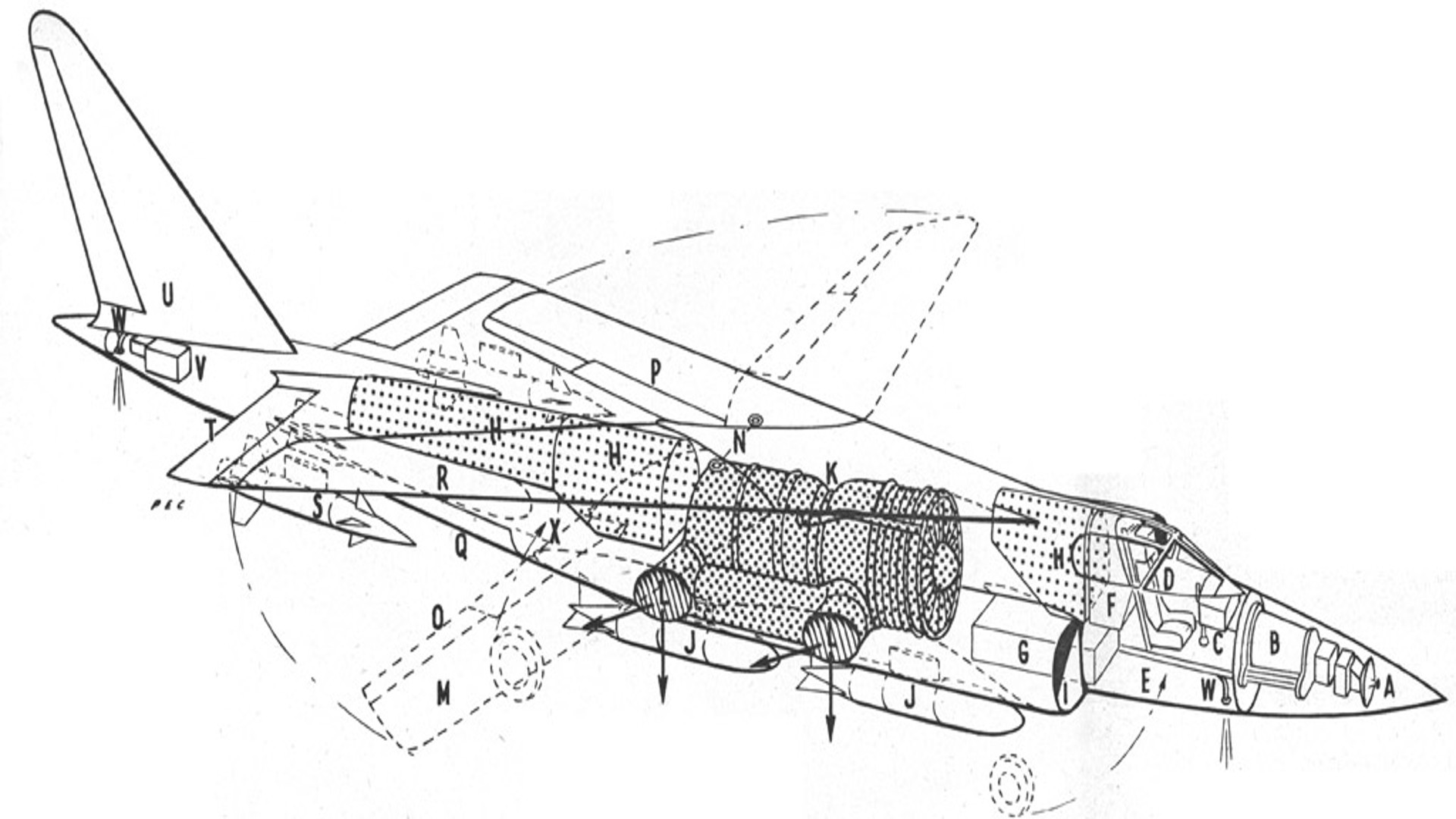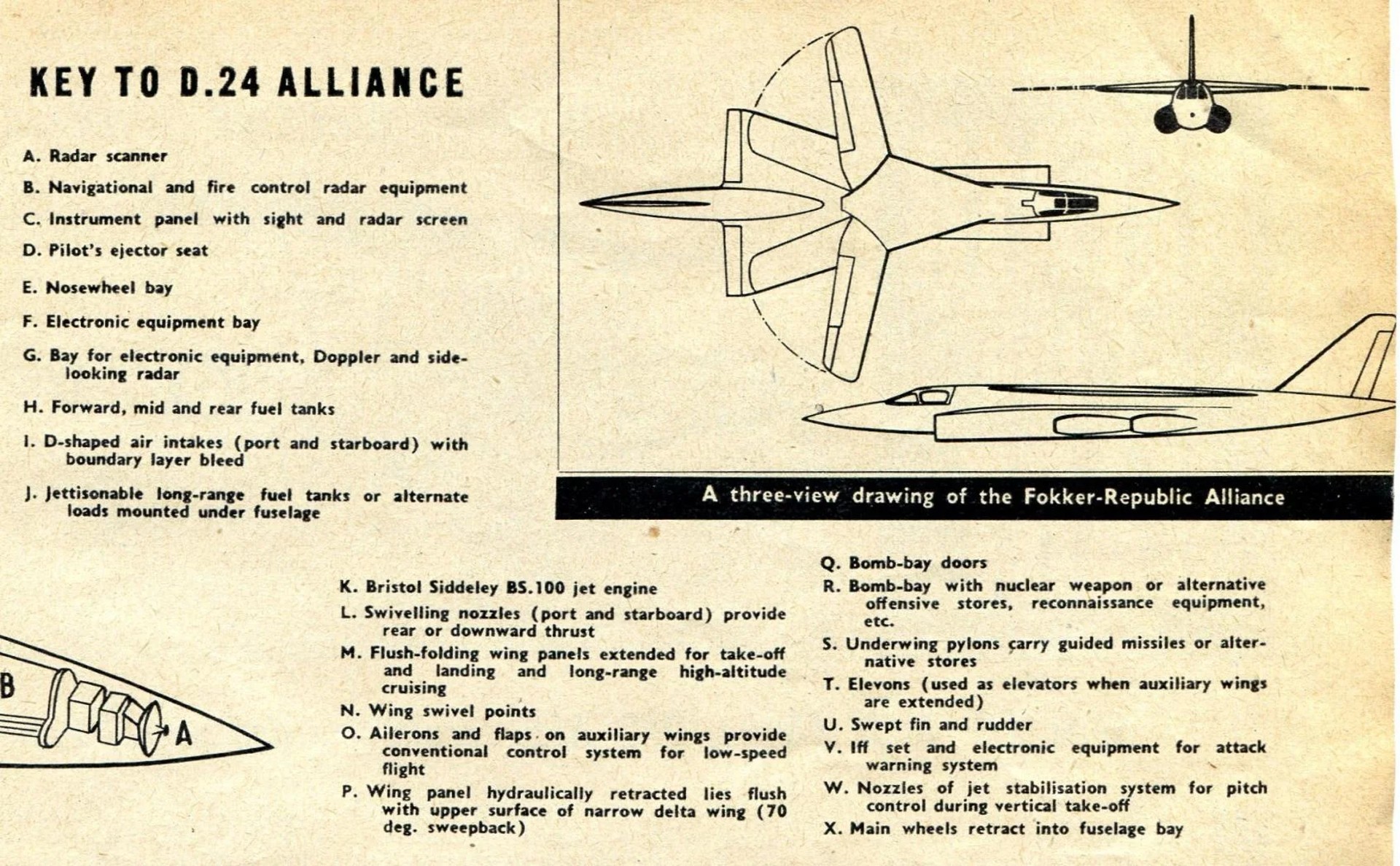Hello everyone, today I’ve got a very unique and really cool aircraft to show you all!
The Fokker-Republic D-24 “Alliance”!
An artist impression of the aircraft.
-Important-
This aircraft did not make it past the scale windtunnel model stage!
I just wanted to make this post to share this information about this aircraft because I do like it very much and it’s quite a one of a kind.
With that out of the way, let’s begin!
History
Spoiler
In the early 1960s, NATO drew up the Basic Military Requirement 3. A competition was launched for a supersonic V / STOL fighter aircraft for the AC / 169 specification. In January 1962, four manufacturers submitted their design to NATO. Dassault with the Mirage IIIV, BAC with Model 584, Hawker with Model P.1154 and Fokker-Republic with the D-24 “Alliance”. It soon turned out that the P.1154 was technically superior to the other participants. NATO itself was unable to financially support the development of any of these drafts and left this to the respective governments. Partly because of this, the development of all models was quickly discontinued and NATO BMR3 was never implemented.
Another artist impression of the aircraft, note the large missile being carried under the fuselageThe Fokker-Republic Project Team was stationed at Schiphol and was led by Alexander Wadkowsky of Republic Aviation. The project team was created to design a fighter aircraft that would comply with the NATO BMR-3 program. The D-24 “Alliance” was the proposal for the NATO VTOL fighter that they came up with. The D-24 would have been somewhat akin to the Republic XF-103, though slower. It would have had a range of 3,000 miles (4828 km) at Mach 1.5, and an internal weapons carriage of multiple long-range air-to-air missiles. It was intended to defeat the atmospheric threat of high performance, cruise-missile launching bombers. It would feature autonomous sensing, so there would have been no dependence on AWACS.
Most likely another model of the aircraft
Development
Spoiler
From the beginning of the collaboration, there was a lot of rivalry between the employees of Fokker and Republic. Nationalistic feelings played a major role in this, but both partners also saw each other as competitors. Nonetheless the development team did fully design the aircraft on paper, made many scale models and test a windtunnel model of the aircraft to calculate the speculated performance.
A model of the “Alliance” that is in the Air Museum in Lelystad
The wing had a variable arrow position and consisted of a fixed delta-shaped wing combined with an adjustable wing. The adjustable wing slid over the delta wing. This would allow the aircraft to fly at lower speeds with the wings extended. Also due to this special wing construction, the “Alliance” did not need horizontal tail surfaces and only had one single conventional rudder.
It was proposed that the vectored-thrust Bristol Siddeley BS.100/3 engine with a thrust potential of 17500kg would be used for the “Alliance”, with plenum chamber burning in the two forward swiveling nozzles, and it was calculated that the VTO (Vertical Take Off) weight, with 2270kg of useful military load, would be 15,875kg. While STO (Short Take Off) weight would rise to 20,400kg or more. Anticipated performance included Mach 1.25 capability at 150m rising to Mach 2.4 at altitude, with service ceiling topping 21,335m.
The Bristol Siddeley BS.100/3 engineIn the end the requirements for the “Alliance” proved to be way to much from the beginning, as is the case with many supersonic aircraft designs around this time, many were way to modern and simply to far ahead of their time. Ultimately the project fell apart due to all the reasons mentioned above, and the project was never continued.
Another model of the “Alliance”
Specifications
Spoiler
General characteristics
Crew: 1 pilot
Length: 20,815 m
Wingspan: 5,690 m with retracted wings / 11,025 m with extended wings
Height: 3,325 m
Wing area: 29,85 m² with retracted wings / 38,60 m² with extended wings
Aspect ratio: 1,09 with retracted wings / 3,15 with extended wings
Max takeoff weight: 15875 kg (Vertical Take Off) / 20400 kg (Short Take Off)
Fuel capacity: 4050 kg
Powerplant: Bristol Siddeley BS.100/3 vectored thrust, turbofan aero engine, 17500 kg thrustPerformance
Maximum speed: Mach 1.25 at sea level / Mach 2.4 above 12 000 m
Maximum range: 4828 km (At Mach 1.5)
Service ceiling: 21335 mArmament
Guns: None
Internal bomb-bay: 1 x Nuclear weapon, reconnaissance equipment or alternate stores
Centerline hardpoints: 2 × Fuel tanks or alternate loads
Underwing pylons: 2 × Guided missiles or alternate stores

Anyways that’s all for now! I hope you enjoyed reading this post, and be sure to put your vote in the poll above!
See you on the battlefield!
More images
Spoiler
Sources
Spoiler
History & Specifications
Photos & Specifications
Extra


















